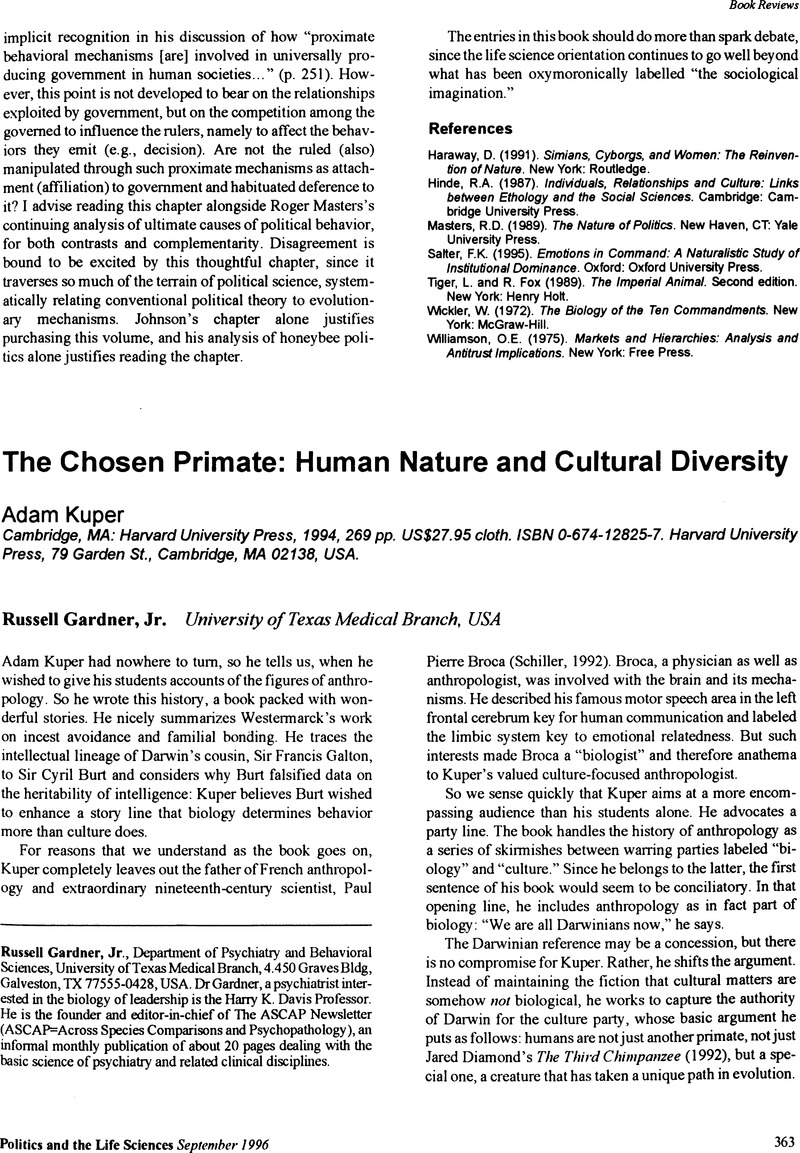No CrossRef data available.
Article contents
The Chosen Primate: Human Nature and Cultural Diversity. Adam Kuper. Cambridge, MA:Harvard University Press,1994, 269 pp. US$27.95 cloth. ISBN 0-674-12825-7. Harvard University Press, 79 Garden St., Cambridge, MA 02138, USA.
Published online by Cambridge University Press: 17 May 2016
Abstract
An abstract is not available for this content so a preview has been provided. Please use the Get access link above for information on how to access this content.

- Type
- Book Reviews
- Information
- Copyright
- Copyright © Association for Politics and the Life Sciences
References
Bailey, K. (1996a). “Mismatch Theory 1: Basic Principles.” The ASCAP Newsletter 9(2):7–9.Google Scholar
Bailey, K. (1996b). “Mismatch Theory 2: Reconciliation and the Fourfold Model.” The ASCAP Newsletter 9(3):5–7.Google Scholar
Budiansky, S. (1992). The Covenant of the Wild: Why Animals Chose Domestication. New York: William Morrow.Google Scholar
Calvin, W.H. (1990). The Ascent of Mind: Ice Age Climates and the Evolution of Intelligence. New York: Bantam Books.Google Scholar
Calvin, W.H. and Ojemann, G.A. (1994). Conversations with Neil's Brain: The Neural Language of Thought and Language. Reading, MA: Addison-Wesley.Google Scholar
Diamond, J. (1992). The Third Chimpanzee: The Evolution and Future of the Human Animal. New York: Harper Collins.Google Scholar
Donald, M. (1991). Origins of the Modern Mind: Three Stages in the Evolution of Culture and Cognition. Cambridge, MA: Harvard University Press.Google Scholar
Gardner, R. (1996). “The Bhagavad Gita and the Frontal Lobes.” The ASCAP Newsletter 9(3):9–16.Google Scholar
Jones, J.H. (1981). Bad Blood: The Tuskegee Syphilis Experiment. New York: Free Press.Google Scholar
Mayr, E. (1982). The Growth of Biological Thought: Diversity, Evolution, and Inheritance. Cambridge, MA: Harvard University Press.Google Scholar
Schiller, F. (1992). Paul Broca: Explorer of the Brain. New York: Oxford University Press.Google Scholar
Trinkaus, E. and Shipman, P. (1992). The Neandertals: Of Skeletons, Scientists, and Scandal. New York: Vintage Books.Google Scholar




